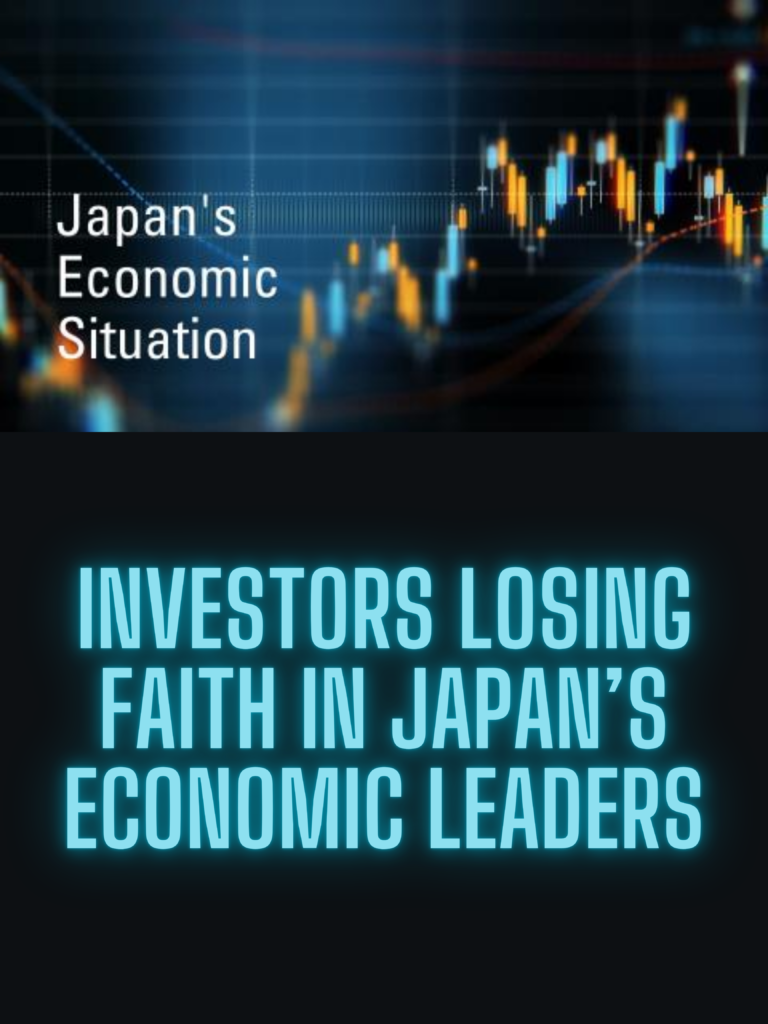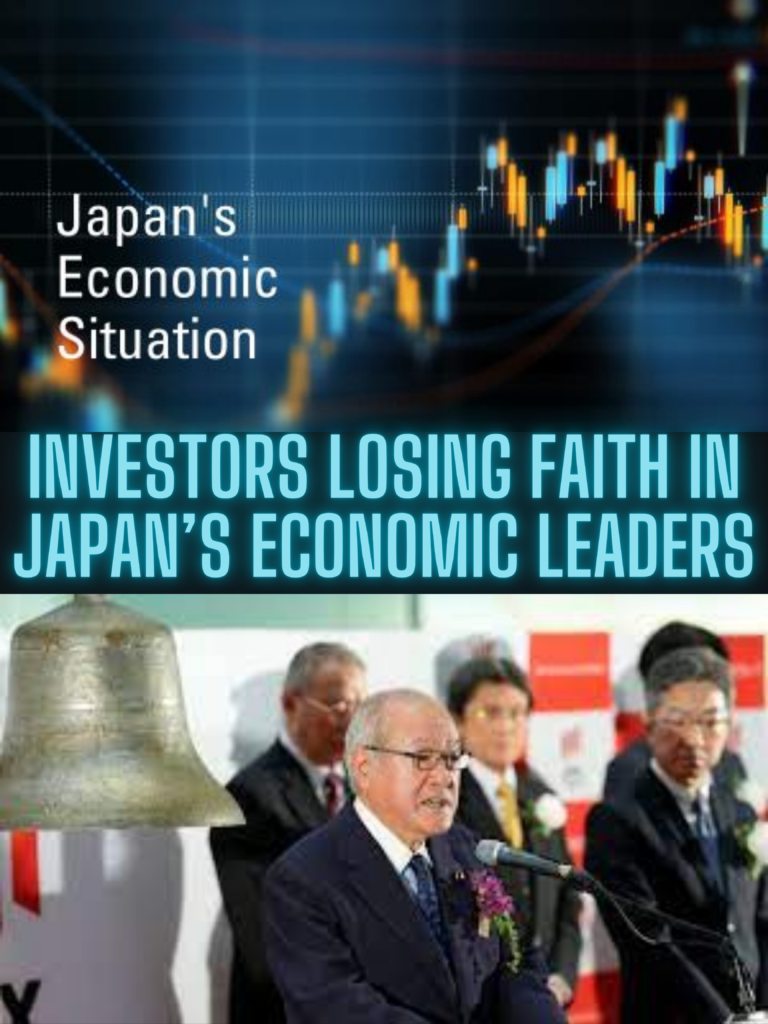Introduction:
Japan, a nation grappling with natural disasters and economic tremors, finds itself at a crossroads that has left investors skeptical and wary. The recent earthquake, coupled with a tumultuous start to the year in financial markets, has spotlighted concerns about the Bank of Japan’s (BOJ) ability to navigate the complexities of policy normalization. This article explores the intricacies of the current economic landscape in Japan and delves into the 12 pivotal reasons behind investors’ diminishing faith in the Japan’s Economic Leaders.

12 Reasons Investors Losing Faith in Japan’s Economic Leaders
- 1. Natural Disasters and Economic Shockwaves:
- 2. Aviation Mishap and Market Jitters:
- 3. Yen's Decline and Investor Skepticism:
- 4. BOJ's Policy Toolbox: Japan’s Economic Leaders
- 5. YCC Tweaks and Unsettled Markets:
- 6. Policy Rate Standstill: Japan’s Economic Leaders
- 7. Governor Ueda's Statements: Japan’s Economic Leaders
- 8. Patient Management and Wage Increase:
- 9. Data Dependency and Inflation Expectations:
- 10. Commercial Banks and Yield Curve Dynamics:
- 11. Policy Rate and Cash-Flow Burden: Japan’s Economic Leaders
- 12. Quantitative Tightening Dilemma:
- Conclusion: Japan’s Economic Leaders
- Answer Covered People also ask
- Disclaimer
1. Natural Disasters and Economic Shockwaves:
The earthquake that struck the Noto peninsula on January 1, 2024, set the stage for a tumultuous year. As Japan grapples with the aftermath, investors are questioning the resilience of the economy in the face of such unforeseen events.
2. Aviation Mishap and Market Jitters:
The collision at Haneda airport between a Japan Airlines plane and a coast-guard aircraft further rattled confidence. The incident, occurring on the heels of the earthquake, contributed to market uncertainties, triggering a sharp decline in the Tokyo stock market.
3. Yen’s Decline and Investor Skepticism:
The weakening of the yen against major currencies, notably the U.S. dollar and the euro, has raised doubts about the BOJ’s readiness to implement effective policies to stabilize the currency and bolster investor confidence.
4. BOJ’s Policy Toolbox: Japan’s Economic Leaders
A closer examination of the BOJ’s policy tools — policy rate, yield curve control (YCC), and quantitative and qualitative easing (QQE) — reveals a complicated framework that requires adept handling to maintain economic stability.
5. YCC Tweaks and Unsettled Markets:
The frequent adjustments to the YCC mechanism, with the 10-year bond rate ceiling raised multiple times, have left investors questioning the BOJ’s strategy and its ability to provide a clear and consistent policy direction.

6. Policy Rate Standstill: Japan’s Economic Leaders
While the YCC undergoes modifications, the policy rate has remained at minus-10 basis points since January 2016, contributing to uncertainty about the BOJ’s commitment to normalizing policy and addressing economic challenges.
7. Governor Ueda’s Statements: Japan’s Economic Leaders
BOJ Governor Kazuo Ueda’s statements regarding the timing of policy tightening have added to market turbulence. The ambiguity surrounding the initiation of tightening measures has left investors on edge.
8. Patient Management and Wage Increase:
Governor Ueda’s emphasis on managing policy patiently and linking interest rate hikes to substantial wage increases has created anticipation, with eyes now set on the April 25-26 policy board meeting.
9. Data Dependency and Inflation Expectations:
Investor confidence is contingent on data, particularly wage increases and inflation rates. The need for inflation expectations to anchor at 2% has added an extra layer of uncertainty.
10. Commercial Banks and Yield Curve Dynamics:
The gradual shift in the yield curve, if managed smoothly, could benefit commercial banks. However, a sudden spike in overnight rates could lead to turmoil, drawing parallels with the Silicon Valley Bank incident in the U.S. last year.
11. Policy Rate and Cash-Flow Burden: Japan’s Economic Leaders
Raising the policy rate poses challenges, including the potential imposition of a cash-flow burden on the BOJ. The shift from negative rates to zero or above carries implications for the central bank’s financial stability.
12. Quantitative Tightening Dilemma:
The most intricate aspect of policy normalization lies in quantitative tightening. Executing this too swiftly may adversely impact debt management and miss opportunities to optimize the bond portfolio.
Conclusion: Japan’s Economic Leaders
Japan’s economic landscape is undergoing a transformation, and the BOJ faces a challenging year ahead. Investors are closely watching policy decisions and economic indicators, seeking clarity and assurance that Japan’s economic leaders can guide the nation through the storm. As uncertainties persist, the need for transparent communication and strategic policy implementation becomes paramount to restore investors’ faith in Japan’s economic trajectory.
Answer Covered People also ask
1.What caused the deflation in Japan?
2.What was Japan’s emergence as an economic power?
3.How did the Japanese economy benefit from the Korean War?
Disclaimer
This article has been created on the basis of internal data, information available publicly, and other reliable sources to be believed. The article may also include information which are the personal views/opinions of the authors. The information included in this article is for general, educational, and awareness purposes only and is not a full disclosure of every material fact.
All the information on this website i.e. World Virtual CFO – is published in good faith and for general information purposes only. World Virtual CFO does not make any warranties about the completeness, reliability, and accuracy of this information. These are my views for only information purposes. Any action you take upon the information you find on this website (World Virtual CFO), is strictly at your own risk. World Virtual CFO will not be liable for any losses and/or damages in connection with using our website. For details please refer to our disclaimer page.
Dr. Dinesh Sharma is an award-winning CFO and AI strategist with over two decades of experience in financial leadership, digital transformation, and business optimization. As the founder of multiple niche platforms—including WorldVirtualCFO.com—he empowers professionals and organizations with strategic insights, system structuring, and innovative tools for sustainable growth. His blogs and e-books blend precision with vision, making complex financial and technological concepts accessible and actionable.